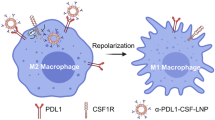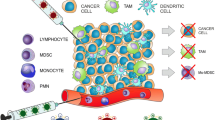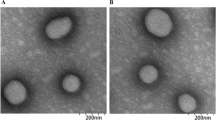Abstract
Tumor-associated macrophages (TAMs) are of major importance in cancer-related immune suppression, and tumor infiltration by CD163pos TAMs is associated with poor outcome in most human cancers. Therefore, therapeutic strategies for reprogramming TAMs from a tumor-supporting (M2-like) phenotype towards a tumoricidal (M1-like) phenotype are of great interest. Activation of the transcription factor STAT3 within the tumor microenvironment is associated with worse prognosis, and STAT3 activation promotes the immunosuppressive phenotype of TAMs. Therefore, we aimed to develop a drug for inhibition of STAT3 specifically within human TAMs by targeting the endocytic CD163 scavenger receptor, which is highly expressed on TAMs. Here, we report the first data on a CD163-targeted STAT3-inhibitory drug consisting of corosolic acid (CA) packaged within long-circulating liposomes (LCLs), which are CD163-targeted by modification with monoclonal anti-CD163 antibodies (αCD163)—CA-LCL-αCD163. We show, that activation of STAT3 (by phosphorylation) was inhibited by CA-LCL-αCD163 specifically within CD163pos cells, with minor effect on CD163neg cells. Furthermore, CA-LCL-αCD163 inhibited STAT3-regulated gene expression of IL-10, and increased expression of TNFα, thus indicating a pro-inflammatory effect of the drug on human macrophages. This M1-like reprogramming at the mRNA level was confirmed by significantly elevated levels of pro-inflammatory cytokines (IFNγ, IL-12, TNFα, IL-2) in the culture medium. Since liposomes are attractive vehicles for novel anti-cancer drugs, and since direct TAM-targeting may decrease adverse effects of systemic inhibition of STAT3, the present results encourage future investigation of CA-LCL-αCD163 in the in vivo setting.






Similar content being viewed by others
Abbreviations
- CA:
-
Corosolic acid
- EPR effect:
-
Enhanced permeability and retention effect
- LCL:
-
Long-circulating liposome
- MDMs:
-
Monocyte-derived macrophages
- MFI:
-
Median fluorescence intensity
- PEG:
-
Polyethylene glycol
- pSTAT3:
-
P-(Y705)-STAT3:activated STAT3 by Tyr-705-phosphorylation
- STAT3:
-
Signal transducer and activator of transcription 3
- TAMs:
-
Tumor-associated macrophages
- UT:
-
Untreated sample
References
Hanahan D, Weinberg RA (2011) Hallmarks of cancer: the next generation. Cell 144:646–674. https://doi.org/10.1016/j.cell.2011.02.013
Gibney GT, Weiner LM, Atkins MB (2016) Predictive biomarkers for checkpoint inhibitor-based immunotherapy. Lancet Oncol 17:e542–e551. https://doi.org/10.1016/S1470-2045(16)30406-5
Noy R, Pollard JW (2014) Tumor-associated macrophages: from mechanisms to therapy. Immunity 41:49–61. https://doi.org/10.1016/j.immuni.2014.06.010
Komohara Y, Fujiwara Y, Ohnishi K, Takeya M (2016) Tumor-associated macrophages: potential therapeutic targets for anti-cancer therapy. Adv Drug Deliv Rev 99:180–185. https://doi.org/10.1016/j.addr.2015.11.009
Zhang Q-W, Liu L, Gong C-Y et al (2012) Prognostic significance of tumor-associated macrophages in solid tumor: a meta-analysis of the literature. PLoS One 7:e50946. https://doi.org/10.1371/journal.pone.0050946
Komohara Y, Niino D, Ohnishi K et al (2015) Role of tumor-associated macrophages in hematological malignancies. Pathol Int 65:170–176. https://doi.org/10.1111/pin.12259
Yang M, McKay D, Pollard JW, Lewis CE (2018) Diverse functions of macrophages in different tumor microenvironments. Cancer Res 78:5492–5503. https://doi.org/10.1158/0008-5472.CAN-18-1367
Porcheray F, Viaud S, Rimaniol A-C et al (2005) Macrophage activation switching: an asset for the resolution of inflammation. Clin Exp Immunol 142:481–489. https://doi.org/10.1111/j.1365-2249.2005.02934.x
Biswas SK, Mantovani A (2010) Macrophage plasticity and interaction with lymphocyte subsets: cancer as a paradigm. Nat Immunol 11:889–896. https://doi.org/10.1038/ni.1937
Hagemann T, Lawrence T, McNeish I et al (2008) “Re-educating” tumor-associated macrophages by targeting NF-κB. J Exp Med 205:1261–1268. https://doi.org/10.1136/ard.59.suppl_1.i54
Duluc D, Corvaisier M, Blanchard S et al (2009) Interferon-gamma reverses the immunosuppressive and protumoral properties and prevents the generation of human tumor-associated macrophages. Int J Cancer 125:367–373. https://doi.org/10.1002/ijc.24401
Awad RM, De Vlaeminck Y, Maebe J et al (2018) Turn back the time: targeting tumor infiltrating myeloid cells to revert cancer progression. Front Immunol 9:1977. https://doi.org/10.3389/fimmu.2018.01977
DeNardo DG, Brennan DJ, Rexhepaj E et al (2011) Leukocyte complexity predicts breast cancer survival and functionally regulates response to chemotherapy. Cancer Discov 1:54–67. https://doi.org/10.1158/2159-8274.CD-10-0028
Pyonteck SM, Akkari L, Schuhmacher AJ et al (2013) CSF-1R inhibition alters macrophage polarization and blocks glioma progression. Nat Med 19:1264–1272. https://doi.org/10.1038/nm.3337
Ries CH, Cannarile MA, Hoves S et al (2014) Targeting tumor-associated macrophages with anti-CSF-1R antibody reveals a strategy for cancer therapy. Cancer Cell 25:846–859. https://doi.org/10.1016/j.ccr.2014.05.016
Quail DF, Joyce JA (2017) Molecular pathways: deciphering mechanisms of resistance to macrophage-targeted therapies. Clin Cancer Res 23:876–884. https://doi.org/10.1158/1078-0432.CCR-16-0133
Yu H, Pardoll D, Jove R (2009) STATs in cancer inflammation and immunity: a leading role for STAT3. Nat Rev Cancer 9:798–809. https://doi.org/10.1038/nrc2734
Yu H, Lee H, Herrmann A et al (2014) Revisiting STAT3 signalling in cancer: new and unexpected biological functions. Nat Rev Cancer 14:736–746. https://doi.org/10.1038/nrc3818
Su Y-L, Banerjee S, White SV, Kortylewski M (2018) STAT3 in tumor-associated myeloid cells: multitasking to disrupt immunity. Int J Mol Sci. https://doi.org/10.3390/ijms19061803
Mukherjee S, Hussaini R, White R et al (2018) TriCurin, a synergistic formulation of curcumin, resveratrol, and epicatechin gallate, repolarizes tumor-associated macrophages and triggers an immune response to cause suppression of HPV+ tumors. Cancer Immunol Immunother 67:761–774. https://doi.org/10.1007/s00262-018-2130-3
Mano Y, Aishima S, Fujita N et al (2013) Tumor-associated macrophage promotes tumor progression via STAT3 signaling in hepatocellular carcinoma. Pathobiology 80:146–154. https://doi.org/10.1159/000346196
Chai EZP, Shanmugam MK, Arfuso F et al (2016) Targeting transcription factor STAT3 for cancer prevention and therapy. Pharmacol Ther 162:86–97. https://doi.org/10.1016/j.pharmthera.2015.10.004
Cheng F, Cheng F, Wang H-W et al (2003) A critical role for Stat3 signaling in immune tolerance. Immunity 19:425–436. https://doi.org/10.1016/S1074-7613(03)00232-2
Sun Z, Yao Z, Liu S et al (2006) An oligonucleotide decoy for Stat3 activates the immune response of macrophages to breast cancer. Immunobiology 211:199–209. https://doi.org/10.1016/j.imbio.2005.11.004
Zhang L, Alizadeh D, Van Handel M et al (2009) Stat3 inhibition activates tumor macrophages and abrogates glioma growth in mice. Glia 57:1458–1467. https://doi.org/10.1002/glia.20863
Kortylewski M, Kujawski M, Wang T et al (2005) Inhibiting Stat3 signaling in the hematopoietic system elicits multicomponent antitumor immunity. Nat Med 11:1314–1321. https://doi.org/10.1038/nm1325
Herrmann A, Kortylewski M, Kujawski M et al (2010) Targeting Stat3 in the myeloid compartment drastically improves the in vivo antitumor functions of adoptively transferred T cells. Cancer Res 70:7455–7464. https://doi.org/10.1158/0008-5472.CAN-10-0736
Dang W, Tang H, Cao H et al (2015) Strategy of STAT3β cell-specific expression in macrophages exhibits antitumor effects on mouse breast cancer. Gene Ther 22:977–983. https://doi.org/10.1038/gt.2015.70
Giurisato E, Xu Q, Lonardi S et al (2018) Myeloid ERK5 deficiency suppresses tumor growth by blocking protumor macrophage polarization via STAT3 inhibition. Proc Natl Acad Sci 115:E2801–E2810. https://doi.org/10.1073/pnas.1707929115
Solinas G, Germano G, Mantovani A, Allavena P (2009) Tumor-associated macrophages (TAM) as major players of the cancer-related inflammation. J Leukoc Biol 86:1065–1073. https://doi.org/10.1189/jlb.0609385
Komohara Y, Jinushi M, Takeya M (2014) Clinical significance of macrophage heterogeneity in human malignant tumors. Cancer Sci 105:1–8. https://doi.org/10.1111/cas.12314
Jensen TO, Schmidt H, Møller HJ et al (2009) Macrophage markers in serum and tumor have prognostic impact in american joint committee on cancer stage I/II melanoma. J Clin Oncol 27:3330–3337. https://doi.org/10.1200/JCO.2008.19.9919
Wada N, Zaki MAA, Hori Y et al (2012) Tumour-associated macrophages in diffuse large B-cell lymphoma: a study of the Osaka Lymphoma Study Group. Histopathology 60:313–319. https://doi.org/10.1111/j.1365-2559.2011.04096.x
Staples KJ, Smallie T, Williams LM et al (2007) IL-10 induces IL-10 in primary human monocyte-derived macrophages via the transcription factor Stat3. J Immunol 178:4779–4785. https://doi.org/10.4049/jimmunol.178.8.4779
Hasita H, Komohara Y, Okabe H et al (2010) Significance of alternatively activated macrophages in patients with intrahepatic cholangiocarcinoma. Cancer Sci 101:1913–1919. https://doi.org/10.1111/j.1349-7006.2010.01614.x
Komohara Y, Komohara Y, Hasita H et al (2011) Macrophage infiltration and its prognostic relevance in clear cell renal cell carcinoma. Cancer Sci 102:1424–1431. https://doi.org/10.1111/j.1349-7006.2011.01945.x
Fujiwara Y, Komohara Y, Ikeda T, Takeya M (2010) Corosolic acid inhibits glioblastoma cell proliferation by suppressing the activation of signal transducer and activator of transcription-3 and nuclear factor-kappa B in tumor cells and tumor-associated macrophages. Cancer Sci 102:206–211. https://doi.org/10.1111/j.1349-7006.2010.01772.x
Horlad H, Fujiwara Y, Takemura K et al (2013) Corosolic acid impairs tumor development and lung metastasis by inhibiting the immunosuppressive activity of myeloid-derived suppressor cells. Mol Nutr Food Res 57:1046–1054. https://doi.org/10.1002/mnfr.201200610
Etzerodt A, Maniecki MB, Graversen JH et al (2012) Efficient intracellular drug-targeting of macrophages using stealth liposomes directed to the hemoglobin scavenger receptor CD163. J Control Release 160:72–80. https://doi.org/10.1016/j.jconrel.2012.01.034
Prabhakar U, Maeda H, Jain RK et al (2013) Challenges and key considerations of the enhanced permeability and retention effect for nanomedicine drug delivery in oncology. Cancer Res 73(8):2412–2417. https://doi.org/10.1158/0008-5472.CAN-12-4561
Ngoune R, Peters A, Elverfeldt von D et al (2016) Accumulating nanoparticles by EPR: A route of no return. J Control Release 238:58–70. https://doi.org/10.1016/j.jconrel.2016.07.028
Clerc S, Barenholz Y (1995) Loading of amphipathic weak acids into liposomes in response to transmembrane calcium acetate gradients. Biochim Biophys Acta 1240:257–265. https://doi.org/10.1016/0005-2736(95)00214-6
Granfeldt A, Hvas CL, Graversen JH et al (2013) Targeting dexamethasone to macrophages in a porcine endotoxemic model. Crit Care Med 41:e309–e318. https://doi.org/10.1097/CCM.0b013e31828a45ef
Andersen MN, Al-Karradi SNH, Kragstrup TW, Hokland M (2016) Elimination of erroneous results in flow cytometry caused by antibody binding to Fc receptors on human monocytes and macrophages. Cytom A 89:1001–1009. https://doi.org/10.1002/cyto.a.22995
Danhier F (2016) To exploit the tumor microenvironment: Since the EPR effect fails in the clinic, what is the future of nanomedicine? J Control Release 244:108–121. https://doi.org/10.1016/j.jconrel.2016.11.015
Oh N, Park JH (2014) Endocytosis and exocytosis of nanoparticles in mammalian cells. IJN 9(Suppl 1):51–63. https://doi.org/10.2147/IJN.S26592
Welte T, Zhang SSM, Wang T et al (2003) STAT3 deletion during hematopoiesis causes Crohn’s disease-like pathogenesis and lethality: a critical role of STAT3 in innate immunity. Proc Natl Acad Sci USA 100:1879–1884. https://doi.org/10.1073/pnas.0237137100
Acknowledgements
All flow cytometry experiments were performed using the LSR Fortessa flow cytometer at the FACS Core Facility, Aarhus University, Denmark. The authors wish to thank Zane Binate, Lene Dabelstein, Helle Ryom, and Christina Sønderskov for excellent technical assistance.
Funding
Institutional funding: Department of Clinical Biochemistry, Aarhus University Hospital, Denmark; and the Faculty of Health, Aarhus University, Denmark. Funding of Morten N Andersen: The Danish Cancer Research Foundation; The Cancer Foundation (Denmark); The Memorial Foundation of Eva and Henry Frænkel; and The Memorial Foundation of Max and Inger Wørzner. Funding of Anders Etzerodt: The Novo Nordisk Foundation.
Author information
Authors and Affiliations
Contributions
Conception and design: MNA, AE, JHG, SKM, MH, HJM. Acquisition of data: MNA, AE, LCH. Analysis and interpretation of data: MNA, AE, MH, HJM. Drafting the article: MNA. All authors revised the manuscript critically, and approved the version to be published.
Corresponding author
Ethics declarations
Conflict of interest
Jonas H. Graversen, Søren K. Moestrup, and Holger J. Møller are minority shareholders in Affinicon ApS, which holds IP protecting the use of CD163 drug targeting. The other authors declare no conflict of interest.
Ethical approval and ethical standards
Buffy coats (residual product from blood processing) were collected anonymously from volunteer donors during routine blood donation at the blood bank, Department of Clinical Immunology, Aarhus University Hospital, Denmark (project number 0094). Volunteers gave informed written consent before blood donation. According to Danish law, this use of anonymized buffy coats does not require separate ethical approval.
Electronic supplementary material
Below is the link to the electronic supplementary material.
Rights and permissions
About this article
Cite this article
Andersen, M.N., Etzerodt, A., Graversen, J.H. et al. STAT3 inhibition specifically in human monocytes and macrophages by CD163-targeted corosolic acid-containing liposomes. Cancer Immunol Immunother 68, 489–502 (2019). https://doi.org/10.1007/s00262-019-02301-3
Received:
Accepted:
Published:
Issue Date:
DOI: https://doi.org/10.1007/s00262-019-02301-3




